BLOG
Designing the Employee Experience for the New World of Work
Economic turbulence. Ripples of resignations. Worker power on the rise. To keep up with fast-changing expectations, businesses need to make employee experience a central pillar in their people strategies.
Companies are still struggling to find their footing on the constantly shifting sands of hybrid and remote workplaces. And now, the increasingly turbulent economy further unsettles the landscape, challenging existing employee experience strategies.
Many organizations are reducing headcount and cutting back on engagement efforts. That’s understandable in the short term, but it’s a mistake to take your eye off the ball completely. Longer term, the war for talent will rage stronger than ever, even if we see a relative truce for a while. The pandemic, the Great Resignation and the demand-driven labor market made people realize that they can choose how and where they work. The mold has been broken and you can’t put it back together. Ignoring the experience elements while the economy slows will only worsen the hiring dilemmas of the future and see the confidence decline of those employees that remain. That means every organization will have to grapple with (if they haven’t already) an employee-centric offering if they are to attract, retain and engage the right talent they need to thrive.
Through our work as people strategists, psychologists, change practitioners and service and product designers, we have helped clients around the world accelerate their employee experience journeys and studied countless experiments and their outcomes. As one might expect, there is no silver bullet. However, our work has shown that experiences that are desirable to employees don’t have to conflict with what is viable and feasible for the business. After all, maximizing desirability, viability and feasibility (DVF) is crucial for creating a long-lasting, sustainable impact on the employee experience.
The economic situation may remove the feeling of urgency, but talent will always have a choice about who they work for and in harder times organizations need to motivate and enable their people to perform, even more than usual. Organizations are still entirely reliant on their people and those that accept the reality of employee power and the demands that come with it will reap the rewards in the long term.
Employee Power is on the Rise
Over the two years of the pandemic, every type of organization had to quickly test and experiment with countless workplace policy updates to stay afloat. Companies didn’t have time to “wait and see”– they had to create new policies in a few days. In some cases early on, companies saw surprising increases in productivity. In a survey carried out by the University of Chicago, 40% of respondents said they believe they are more productive at home while 15% said the reverse is true. Others reported remarkable gains in employee satisfaction, even reaching record levels. And for those workers reporting greater happiness when allowed to work remotely at least some of the time, over 80% reported an improvement in their work-life balance.
But now this picture has evolved to one of burnout, stress and cultural disconnect. Job satisfaction has plunged to a 20-year-low. Women have been especially crushed by this downside, with education and childcare crises forcing millions out of the workplace, likely setting gender pay equity efforts back for more than a generation. And as the Great Resignation, well underway before the pandemic, continues to make hiring harder, the economy is sputtering.
The point is, it’s harder to be an employee than it used to be. Economic uncertainty will make it harder still. Organizations need employees to perform, and it creates an even greater need to provide a stable and productive working environment.
“Employee experience” is a common buzzword that is over-used and ill-defined. For decades, conventional wisdom has dictated employee engagement as the ultimate goal of employee experience. Experts believed that engaged employees are more productive, stay around longer and grow into the leaders of tomorrow. One of the problems with employee engagement is that it is inherently employer centric. Firms want their employees to be engaged with work. But employees crave so much more. They want to be well compensated, valued and connected to a purpose. They no longer compartmentalize their careers and work as separate from their personal lives. They pursue well-being across financial, physical, mental, social and intellectual dimensions.
The New Equation: Flexibility + Connection = Wellbeing
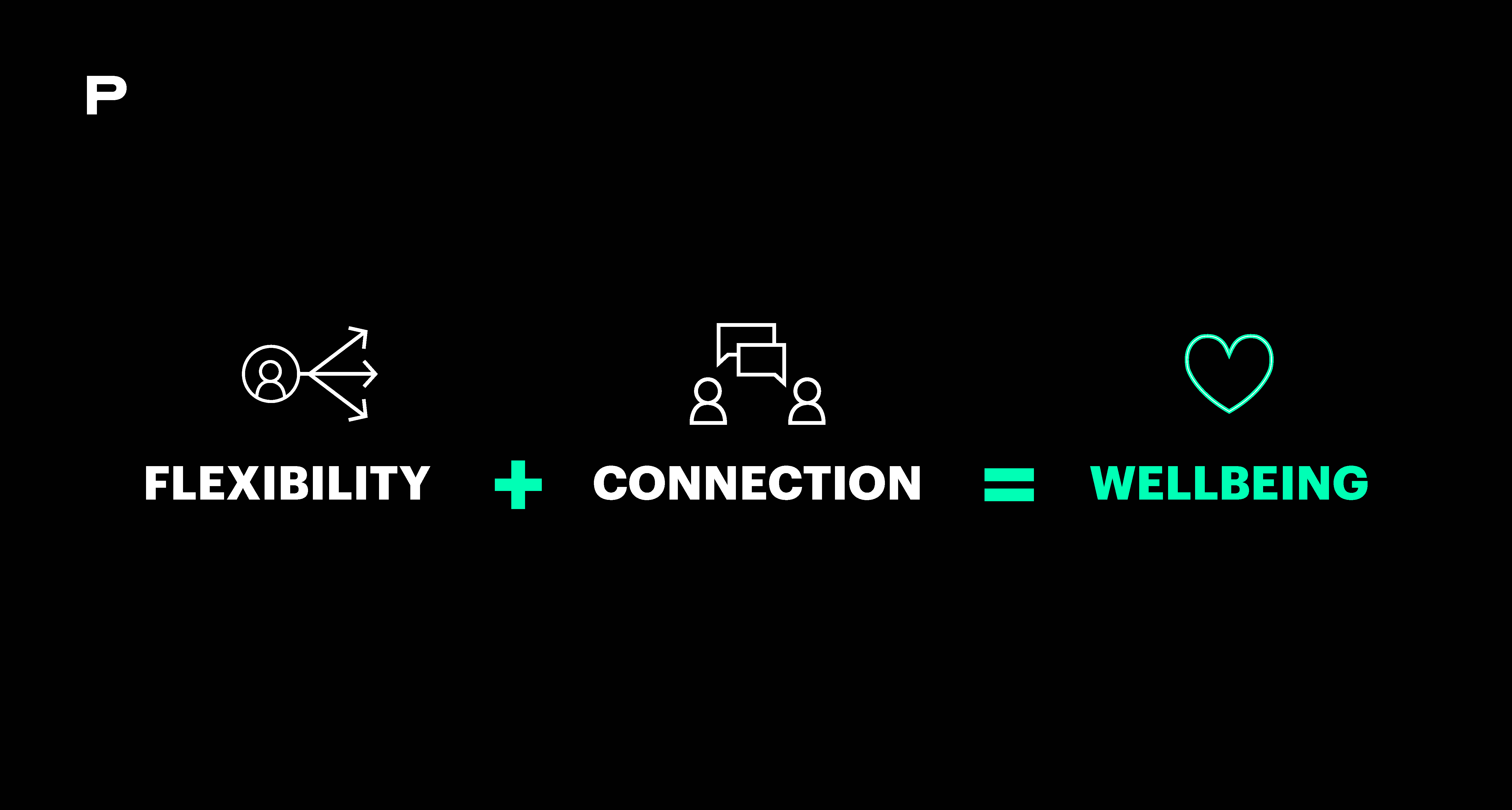
What people want more than anything is holistic well-being. It’s fast becoming the foundational tenant, with a recent survey finding that 80% of employers believe helping workers achieve this well-being is an important objective. Prophet’s research also finds that flexibility and connection are the main levers for getting there.
Flexibility means accounting for individual and team preferences, circumstances and strengths.
Connection, and how people experience it, is complex. It encompasses interpersonal dynamics, relationships and interactions among peers. And it also aligns individuals with the company’s purpose and mission, tapping into their own values. Connection flourishes in inclusive environments when people are psychologically safe and comfortable being themselves at work.
Companies must constantly balance this equation. Any policy that impacts flexibility or connection must be considered.
Designing employee experiences around flexibility and connection creates an environment of:
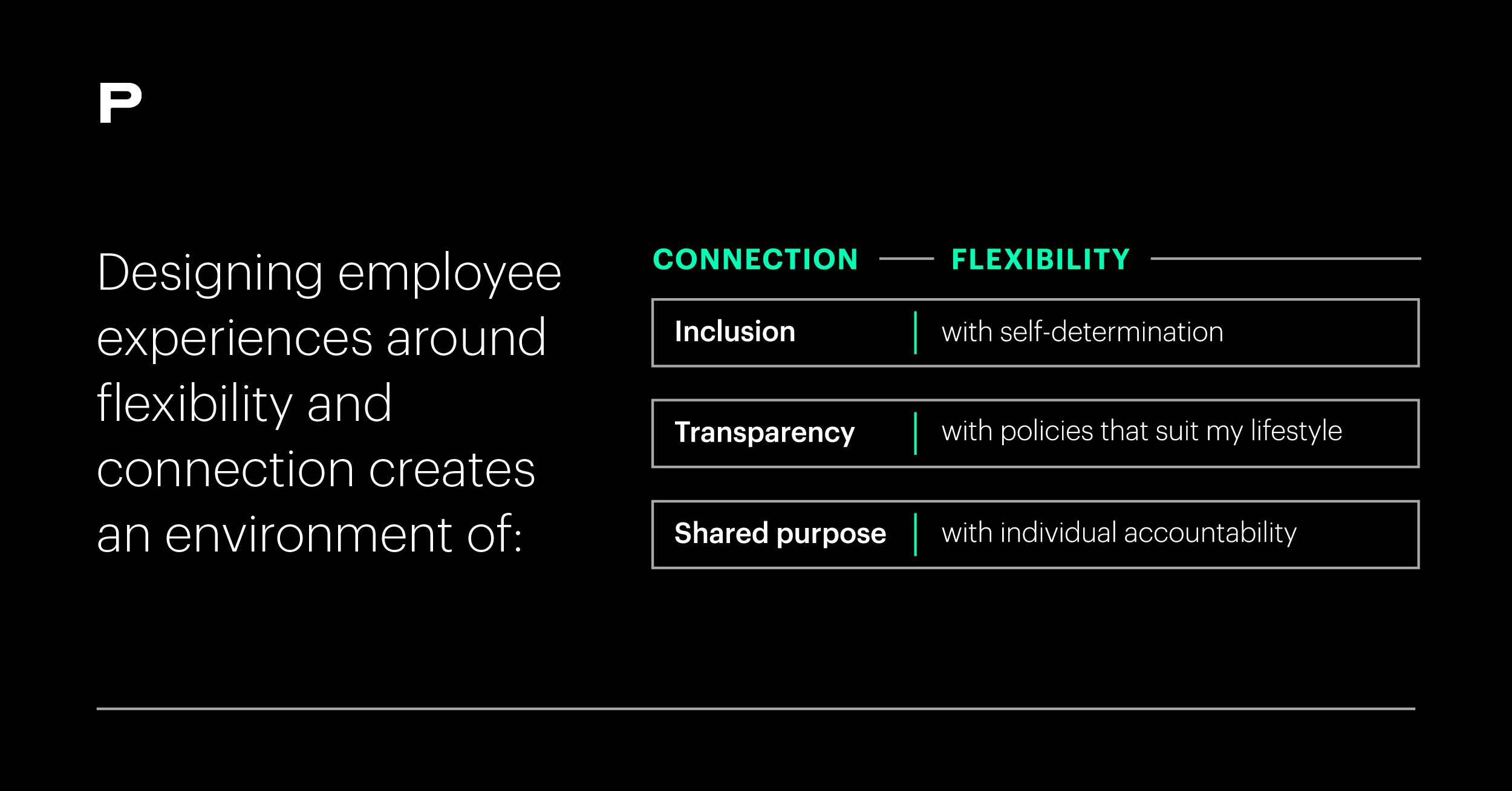
Wellbeing: The New End Goal
Health is now the ultimate headline. People have had the chance to re-evaluate what’s important and possible in their lives. Fed up with outdated norms like the 9-5 schedule and chronic stress and fatigue, employees are less willing to sacrifice their physical, mental and social health for their job.
As a result, employers are now in the hot seat, charged with prioritizing and more actively supporting these health goals. While previously, employers’ duty of care lay solely in the realm of physical health and safety, the pandemic elevated emotional and mental well-being to the same level of priority.
More traditional leaders may raise their eyebrows at the expansive responsibility of providing for employee wellbeing. And some long-tenured executives want to resist this change. But it’s too late. The paradigm has already evolved, and the trends are clear: Employees today have a record level of bargaining power. And even if a slow economy causes a blip, this trend will only get more prevalent, as we enter the era of “employment as a service”. It’s incumbent on employers to develop an experience that is desirable, viable and feasible.
This power shift has been especially acute in retail and food service. When a leading QSR brand engaged Prophet to understand the evolving restaurant workforce, well-being emerged as the central concern. We learned that employees want more than financial gains and physical safety. To them, well-being also meant personal development, solid communities and psychological safety. They wanted a sense that the company cared about them, of course. But they also wanted ways they could demonstrate their care for co-workers.
Those insights helped us to reinvigorate the employee value proposition and identify the moments that matter, along the entire employee journey, developing initiatives and experiences that would allow it to retain current workers and attract top talent. Prophet developed “100 Ways to Care,” an expanded set of team support systems. The customizable and flexible collection of benefits includes instant pay, automated shift scheduling, and holistic wellness options, focusing on company-led and funded mental health and employee assistance. By first establishing essential truths about team members of the next five to 10 years and envisioning what their journey will look like, signature experiences can address needs and opportunities with new capabilities.
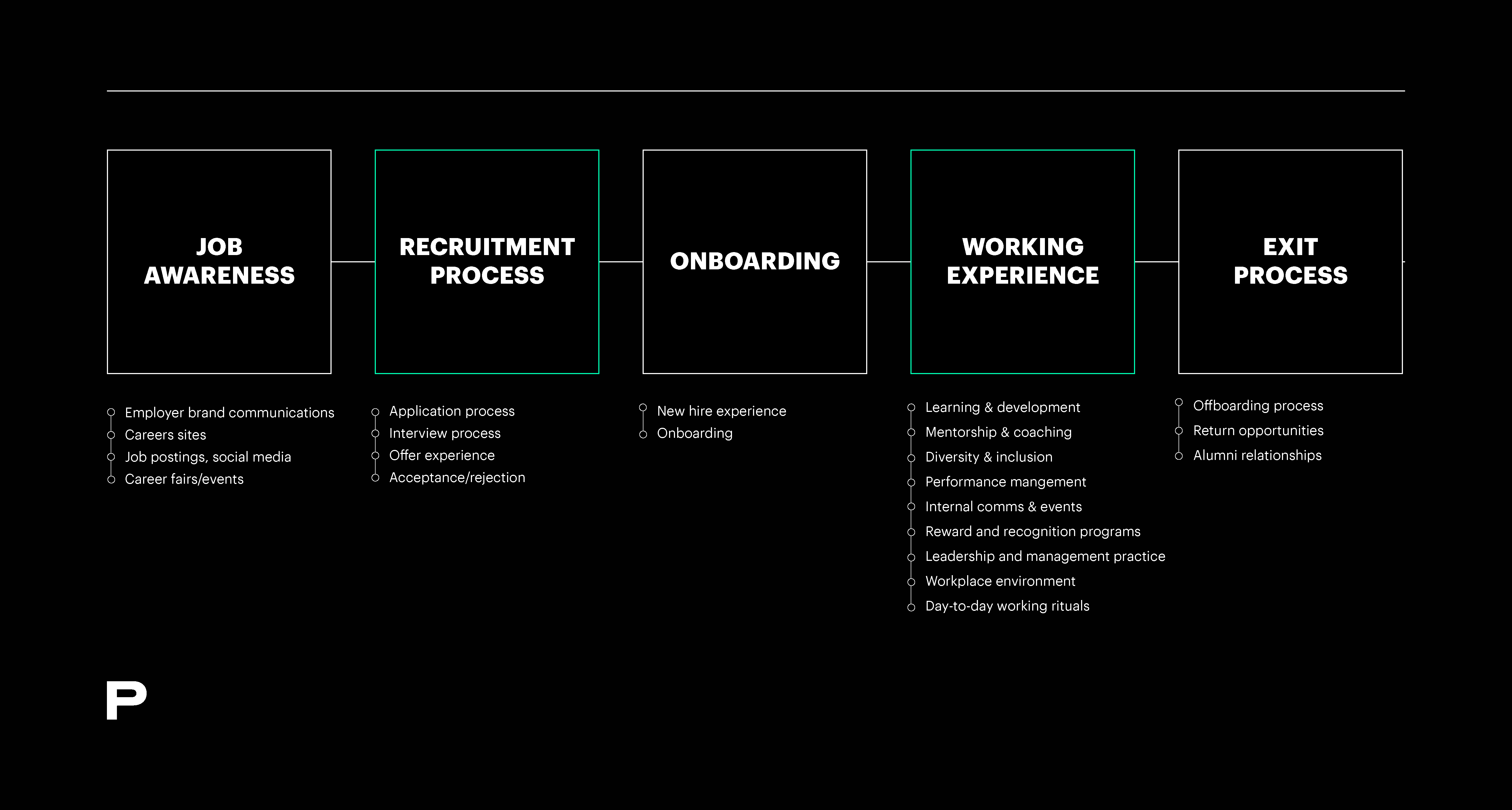
We also developed quantifiable metrics beyond the usual engagement scores to measure the impact of these efforts on the experience. Capturing metrics on a wider range of factors including tenure, attendance, complexity of the role, overall job satisfaction and attention to/interaction with solutions, as well as engagement, enables an ongoing view of “experience” and supports agile refinement and improvement over time.
Other companies are using this holistic approach to make key decisions and reap returns. BP and Bank of America have built mental well-being support and accountability into their leadership cultures. BP gets real-time mental well-being feedback from regular employee engagement surveys to understand how teams feel and how to support them. Bank of America is creating opportunities for colleagues to talk about their mental well-being, breaking down attached stigmas.
Other organizations are taking corrective action with core business activities, demonstrating the power of employee experience (EX) to create significant benefits to customer experience (CX). Mojang Studios of Minecraft fame, for example, recognized the toll that the pandemic and related stress was taking on the well-being of its employees, even as it faced an urgent deadline on the Caves & Cliff Update at Minecraft Live. It decided to delay the update to ease the burden on employees, sharing the news via a blog post. Users of the world’s most popular game, although disappointed, respected that decision. And they responded by pushing Minecraft’s monthly active users to record levels.
That’s not an isolated incident of business benefit, either. One recent study ranked companies by measures of workforce well-being. Those in the highest 10% reported a 27.2% increase in return on equity and a 24.8% gain in profits, substantially higher than their Fortune 500 peers.
The ante is rising. As businesses adapt to growing demands, a holistic well-being strategy will be even more vital to the employee experience. Caring for the entire person–not just who they are at work–is now a table stake when it comes to talent attraction, recruitment and retention. When businesses take care of their people, those people take care of the business.
Flexibility: Developing a Targeted, Flexible Workplace Strategy
Much to the delight of many, hybrid working is here to stay. Even the U.K’s minister for Brexit opportunities and government efficiency has revealed plans to offload £1.5 billion worth of London office space because of the number of civil servants who continue to work from home. More broadly, just over half– 53%– expect a hybrid model going forward, with 24% expecting the option to work remotely all the time.
But for the most part, the policies that initially governed remote work came together in a period of intense panic, implemented in an environment of desperation and uncertainty.
As firms work to create their long-term policies, they have an opportunity to learn from COVID-era flexible working experiments and formalize what started as ad-hoc solutions. As hybrid working becomes the new middle ground, flexibility must become inherent to employee experience. People want to make decisions based on what’s best for them, considering their families, commutes and work-life balance.
Dropbox’s 3,000 employees now work remotely most of the time and go to the office for more collaborative and team-building work. The company redesigned its facilities to make this shift, removing individual desks.
Many financial services companies like Goldman Sachs and Morgan Stanley have drawn a line in the sand for return to the office, wanting employees back five days a week. But fueled by a robust job market, their employees are reluctant to give up flexible working conditions. How can institutions that want employees back full-time compete with others who allow hybrid work?
Prophet worked with one of the U.K.’s leading financial companies to develop a long-term workplace strategy. Early on, it had won rave reviews for its rapid pivot to a work-from-anywhere policy. But as the months ticked by, it realized that culture, morale and engagement began to erode. It needed something beyond a monolithic approach to flexibility. One size, it acknowledged, definitely did not fit all.
And this approach had unintended consequences, including increased pressure on leaders to navigate managing fully remote teams. It also raises the question: How can companies retain the benefits of in-person collaboration, which are proven and time-honored ways to keep people motivated, while preserving the option to be remote?
Our work started – as it always does – by looking through the lens of Prophet’s Human-Centered Transformation Model.
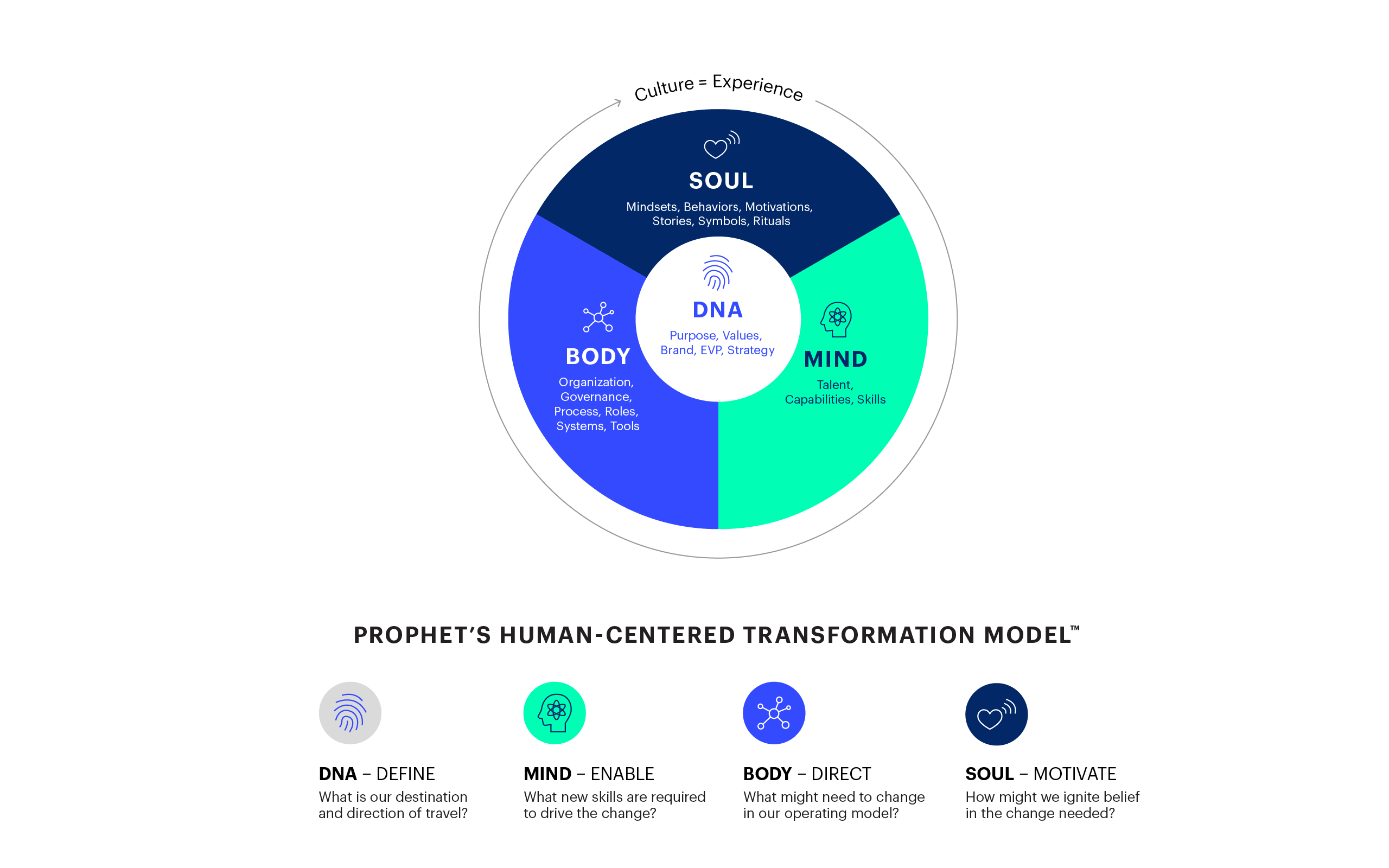
This model looks at organizations as a macrocosm of an individual– with DNA, Mind, Body and Soul– and provides a framework to map the employee journey and address all of the organizational factors that touch on the experience people enjoy day-to-day. In this instance, we took a closer look at the core employee personas and archetypes. While many people reported improved morale and engagement, there was an increased risk of losing a sense of belonging and investment in the company’s culture.
We helped our financial services client create an employee experience strategy that balances the needs of all stakeholders. That meant a shift from flexibility based on individual needs to flexibility that works for all. Instead of asking employees to work from anywhere, they’re now being asked to work from where makes sense for them and their teams – encouraging them to make decisions that balance their individual needs with the needs of the team and the needs of the business. They are also encouraged to make decisions “led by the work.” That encompasses more than just the tasks on their to-do list. It includes learning and development, team building, career conversations and leadership, which all make them feel more connected to the company’s broader mission.
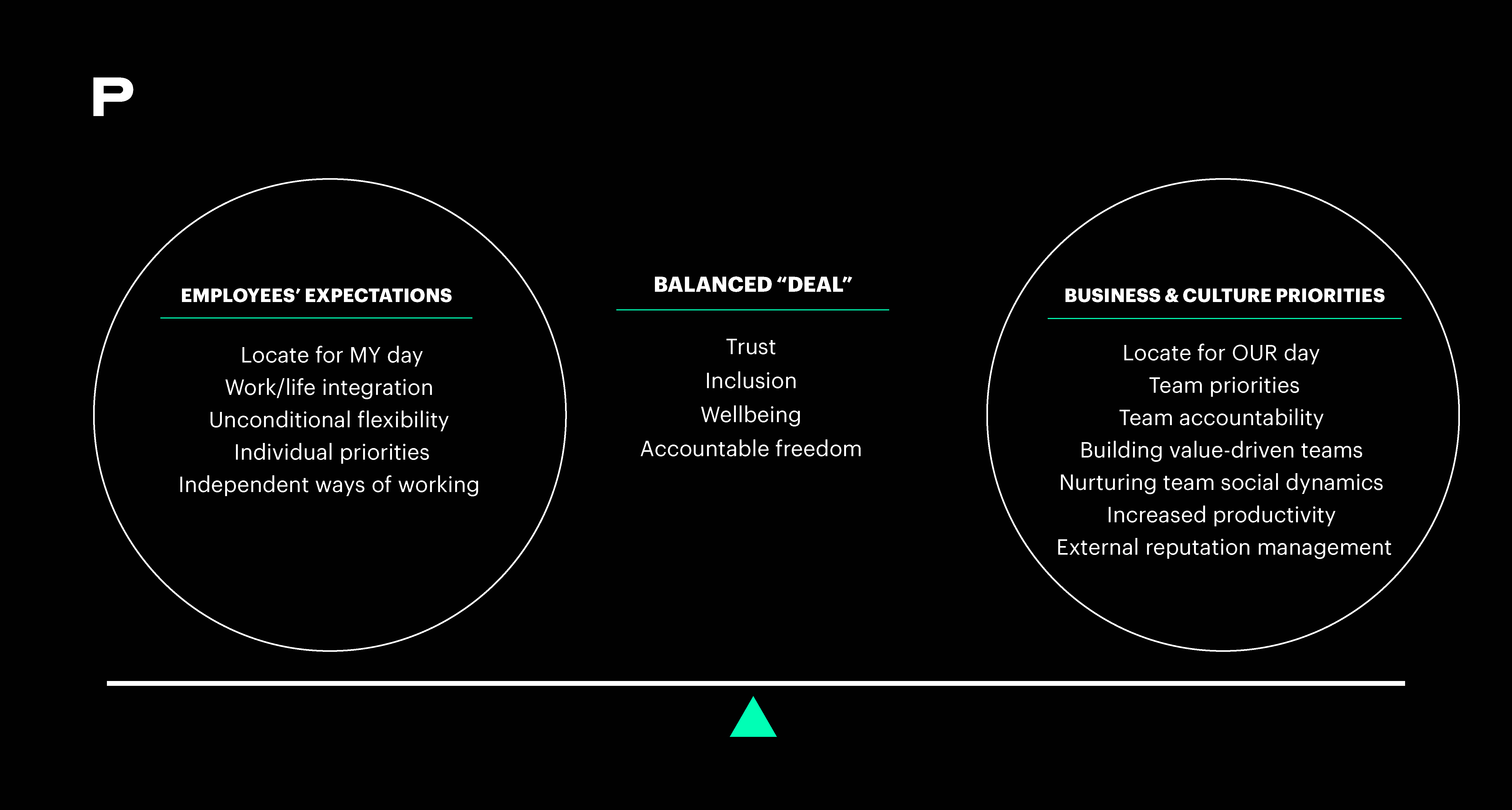
We’ve worked closely with this client to ensure transparent communication around these changes. Employees must understand that this isn’t about the company going backward on its commitment to flexibility. That would damage the employer-employee trust it has nurtured so carefully since the pandemic began.
Instead, it’s working to ensure hybrid work options that provide “freedom within a frame.”
Importantly, much of the focus has been on leadership, ensuring they can be effective in hybrid and remote scenarios, including performance conversations, spotting well-being needs and empowering decision-making. It is also paying more attention to the importance of role modeling. Leadership is both the most significant risk to employee experience policies and also the best amplifier.
We also helped the company expand the different tools and technology used to maintain performance levels and initiate conversations throughout the organization about what good looks like. Today, they can much more easily encourage inclusive practices to ensure equal opportunity for growth across all talent.
An essential outcome of this type of work is that leaders throughout the organization better understand why this all matters and just how valuable a flexible employee experience strategy is. Being more intentional about how an organization defines “flexibility” goes beyond a happier workforce. It strengthens the organization, expanding the talent pool for employers. That includes geographical range, of course, but potential employees who must work from home, such as caregivers, and those who simply prefer remote work.
However, this recruiting advantage will continue to wane as more companies clarify their version of flexibility. That means it’s essential that each organization defines flexibility in a way that meshes with its operations, culture, technology and purpose. Done right, it makes a company’s employee value proposition distinctive and relevant. It becomes a competitive talent advantage.
Representation and Diversity Matter
Employees increasingly want to (re)build a sense of connection to their co-workers, communities and the broader mission of the employer. We used to have the proverbial watercooler to engage in small talk and get up to date on the latest developments. Often, it’s where we built trust, camaraderie and relationships. But in increasingly hybrid and digital environments, companies are still finding it hard to recreate the spontaneity and organic moments to build those connections.
Representation, too, factors deeply into the connection. Employers need to be clear about what diversity, equity and inclusion mean to them and how it aligns with the organization’s values. It needs to be active in the cultural norms and hard-wired into processes, developing metrics to track impact. Research suggests that diverse teams outperform individual decision-makers up to 87% of the time. And DEI initiatives matter to job seekers too, with 64% of candidates saying diversity and inclusion are key factors when evaluating a job offer.
The presence of women in senior management has long been understood to improve financial performance, and new research finds that as firms add more women, they become more open to change and less afraid of risks, increasing psychological safety in the workplace. Specifically, the firms studied shifted towards innovation, investing more in research and development and less in acquisitions.
As companies scramble to make sure their efforts show tangible results, attracting, retaining and motivating key talent through turbulent times, we’re finding that small acts of inclusion have the most impact. Robust employee resource groups for workers of color and LGBTQ+ are a must. So are networks that encourage women, who continue to leave their jobs at higher rates than men.
Prophet’s global research, “The Collaborative Advantage”, finds that one of the biggest barriers to effective organizational collaboration is a lack of clarity on the connection of work to the broader business strategy. Organizations often fail to show employees how working together more closely helps achieve personal and corporate goals. Despite 80% of leaders believing that collaboration produces better outcomes, many are still struggling to meet the collaboration challenge and break down siloed work.
Humans are fundamentally a social species and people want to belong, to be part of a team. And they want those teams to function well, to collaborate in ways that are rewarding to all involved. Our research shows that individuals who work at more collaborative organizations aren’t just more productive and satisfied. They’re keenly aware that it teaches them valuable new skills and expands their networks.
Connection Starts with Employee Onboarding
Organizations realize that they must be more intentional at creating connections at work, finding new ways to put all kinds of relationships back into play, from formal work roles and team responsibilities to friendships and side conversations.
It’s especially critical to get this right and set the tone for the new joiners’ tenure. Within an employee’s journey, the onboarding experience can define how engaged employees are within their roles and for how long. We worked with Reltio, a high-growth data management unicorn, to improve, standardize and scale the onboarding experience.
As we spoke to employees across functions and levels, we discovered that new hires depended on the relationships formed in that critical period. In its remote-first environment, Reltio already had a culture of virtual connection and helpfulness, which had become crucial in an employee’s ability to connect and learn important information about the organization.
To better support this informal approach, we articulated “foster relationships”. This became one of five experience principles that now inform how Reltio supports new hires. Designed to recognize relationships as a fundamental need, this ensures that employees can continue to stay in touch and support each other as they find their way within the company. This principle came to life across experience concepts, including buddy systems, pre-scheduled meetings, access to organizational charts that outline roles and teams and one-to-one coffee chats.
The Steep Cost of Standing Still
All this creates an urgent need for companies to sharpen and expand their employee experience. Businesses, even those that were considered highly progressive employers, are losing talent every day. And it doesn’t look like this recent phenomenon is slowing down with a near record-high number of Americans still quitting each month.
Employees, from the most highly sought-after tech executives to fast-food workers, know they have the upper hand. They know they can–and will–find an employer more willing to support their total well-being and in some cases offer a pay rise as well (with a median raise of 16.1% in the US). Recession or not, employee expectations have changed forever.
Twenty years ago, marketers had to accept that the age of customer experience had arrived quickly. Now it’s the employee experience’s turn. Organizations don’t have the luxury of treating the employee experience as an afterthought. They need to be more intentional about every interaction–how they recruit and hire and how they encourage connection. They must acknowledge that individual needs don’t always align with a team or organizational goals.
They can’t–and shouldn’t–revamp their employer brand overnight. But by focusing on the simple equation–Flexibility+ Connection = Wellbeing–they can shape their vision, building a roadmap to working towards over time.
By taking advantage of these turbulent times to reimagine the experience employees enjoy, companies can prepare for the growth journey ahead.
Start with these four general guidelines:
- Of every new experience shift, ask: Is this desirable? Viable? Feasible?
- Tailor the experience strategy and design to clearly symbolize company values and elements of the employee value proposition, aligning them with the corporate purpose and strategy.
- Focus on moments that matter. Employees travel many journeys, and the thing that makes a company great for an entry-level employee may be very different than what matters to a seasoned leader. Understand different employee personas and archetypes.
- Make a balanced, healthy and diverse workforce the new end goal, using flexibility and connection to drive well-being and grow stronger every day.
FINAL THOUGHTS
Employee experience design is a rapidly growing discipline. It’s how organizations can maximize their advantage in the war for talent and take advantage of seismic shifts in working patterns. When employee experience becomes a central pillar in a company’s people strategy, it makes it easier to align with brands, business strategy and customer experience.


